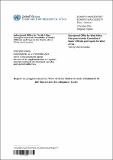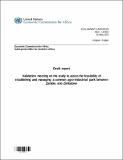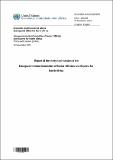| dc.description.abstract | Under the Sustainable Development Goals (SDG) framework, Africa is pursuing broad-based development by addressing constraints to its long-term growth and transformation. The development vision of Africa is anchored on Agenda 2063, articulated through the Africa We Want, and the United Nations Agenda 2030. To meet these goals, by leveraging the immense potential of the continent, further bold steps are needed both in addressing barriers to growth and in adopting forwardlooking policies to create new opportunities for improving livelihoods and increasing prosperity on the continent. The infrastructure gap in Africa is among the greatest barriers to growth, impacting investment across sectors. Beyond the key tenets of SDG7 on bridging electricity access, agricultural, industrial, and service sectors development is tied to the ability to supply sufficient, affordable and reliable energy. Based on 50 years of observation, we have learned that industrial output is elastic to electricity supply, and a 1 percent growth in GDP induces 0.5 percent additional demand for electricity services. Energy is, therefore, at the center of socioeconomic transformation. In the last few years, due to sustained investment to implement SDG7, more than 115 million people gained access to energy. With a goal of at least 75 million new access per year through 2030 to meet SDG7, further bold action is required. This translates into over $90 billion per year of investment to sustain progress. The current funding gap calls for a robust partnership with the private sector. Through UNECA studies, we have demonstrated that a 1 percent increase in private investment in the broader economy in Africa could boost GDP per capita by up to 1.6 percent in the long-run. Investment to bridge the infrastructure gap for transformation through robust private sector participation is also an investment into our future growth. | en |
| dc.title | Towards a prosperous and sustainable Africa: Maximizing the socio-economic gains of Africa’s energy transition | en |
| uneca.subject.fulltaxonomy | UNBIS::NATURAL RESOURCES AND THE ENVIRONMENT::ENVIRONMENT::SUSTAINABLE DEVELOPMENT | en |
| uneca.subject.fulltaxonomy | UNBIS::ECONOMIC DEVELOPMENT AND DEVELOPMENT FINANCE::DEVELOPMENT::ECONOMIC DEVELOPMENT | en |
| uneca.subject.fulltaxonomy | UNBIS::ECONOMIC DEVELOPMENT AND DEVELOPMENT FINANCE::ECONOMIC CONDITIONS | en |
| uneca.subject.fulltaxonomy | UNBIS::NATURAL RESOURCES AND THE ENVIRONMENT::ENERGY RESOURCES::SUSTAINABLE ENERGY | en |
| uneca.subject.fulltaxonomy | UNBIS::GEOGRAPHICAL DESCRIPTORS::AFRICA | en |
| uneca.subject.fulltaxonomy | UNBIS::GEOGRAPHICAL DESCRIPTORS::AFRICA | en |
| uneca.creatorCorporate.fulltaxonomy | Corporate Authors::United Nations. Economic Commission for Africa | en |
| ags.creatorCorporate | United Nations. Economic Commission for Africa | en |
| ags.subjectThesaurus | SUSTAINABLE DEVELOPMENT | en |
| ags.subjectThesaurus | ECONOMIC DEVELOPMENT | en |
| ags.subjectThesaurus | ECONOMIC CONDITIONS | en |
| ags.subjectThesaurus | SUSTAINABLE ENERGY | en |
| ags.subjectThesaurus | AFRICA | en |
| ags.subjectThesaurus | AFRICA | en |
| ags.descriptionNotes | Res4Africa Foundation flagship publication 4th edition in partnership with IRENA and UNECA. | en |
| ags.publisherPlace | Addis Ababa : | en |
| ags.publisherName | UN. ECA, | en |
| dc.date.accessioned | 2022-02-28T08:13:53Z | |
| dc.date.available | 2022-02-28T08:13:53Z | |
| dc.date.issued | 2022 | |
| dc.identifier.uri | https://hdl.handle.net/10855/47541 | |
| dc.format.extent | 154 p.: ill. | |
| dc.language | eng | |
| dc.type | Technical paper | |
| uneca.workflow.processed | true | |
| ags.subjectThesaurus | SUSTAINABLE DEVELOPMENT | |
| ags.subjectThesaurus | ECONOMIC DEVELOPMENT | |
| ags.subjectThesaurus | ECONOMIC CONDITIONS | |
| ags.subjectThesaurus | SUSTAINABLE ENERGY | |
| ags.subjectThesaurus | AFRICA | |
| ags.subjectClassification | 02.02.00 ECONOMIC CONDITIONS | |
| ags.subjectClassification | 02.10.00 DEVELOPMENT FINANCE | |
| ags.availabilityNumber | b12000218 | |
| ags.availabilityNumber | 2022 | |
| ags.availabilityLocation | ECA-HQ | |
| ags.rights.termsofuse | public | |
| ags.JN | b12000218 | |
| uneca.language.supported | en | |




